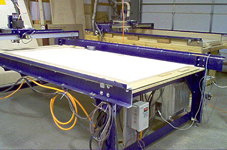|
CNC stands for “computer numeric control”. CNC machining
is the earliest computer controlled rapid prototyping
technique. First CNC systems were driven by simple
controller, where a path was inputted as series of
numeric combinations. Such controllers could be attached
to a milling machine or a lathe, equipped with servo
motors executing movements along x, y and z axis. During
several decades CNC machines evolved into much more
sophisticated systems, able to interpret a direct input
from CAD based 3D files. Today computer controlled
milling machines can precisely cut or carve flat
two-dimensional as well as more complex
three-dimensional shapes.
Unlike additive rapid prototyping methods such as FDM,
SLA or SLS, CNC is a subtractive process. Milling
machine is carving a desired shape out of the whole
instead of building it. This concept gives the CNC
method unique advantages, such as unlimited choice of
materials and relatively low cost of the process.
Practically any machinable material can be carved by CNC
system. A list of materials includes, but not limited to
wood, MDF, wooden and plastic composites, styrene,
acrylic, PVC, PVC foam sheets and other machinable
plastics, tooling boards, curable resins, Styrofoam,
high density foam boards and blocks and many other
materials.
 Architecture of a typical CNC system is fairly simple.
It includes a spindle or router motor turning a cutting
tool at high speed, a cutting tool, and several computer
driven servo motors, executing a movement of the cutting
tool along the trajectory, which is a summary of series
of movements along the x, y and z axis. A CNC control
computer reads and interprets a “toolpath” file,
specially prepared for producing each specific part and
sends a series of commands, called G-code, to the servo
motors. A CNC machine also includes a framework and a
system of rails and guides serving to secure the
material during processing. Architecture of a typical CNC system is fairly simple.
It includes a spindle or router motor turning a cutting
tool at high speed, a cutting tool, and several computer
driven servo motors, executing a movement of the cutting
tool along the trajectory, which is a summary of series
of movements along the x, y and z axis. A CNC control
computer reads and interprets a “toolpath” file,
specially prepared for producing each specific part and
sends a series of commands, called G-code, to the servo
motors. A CNC machine also includes a framework and a
system of rails and guides serving to secure the
material during processing.
Cutting tools and the cutting speed vary over a wide
range. A CNC operator selects appropriate tool and speed
depending on the material being cut and a part’s
properties. Such wide variety of cutting tools (bits)
and cutting speed range are also definite advantages of
the CNC method.
CNC machines come in different sizes and configurations.
They range from small desktop models to large commercial
machines with beds up to 5' wide by 12' long or even
more.
Fast, precise, dependable and inexpensive CNC technique
became a friendly aid of professional model makers’ work
decades ago and stays that way, offering new
opportunities as the CNC systems continue to evolve.
Here are the most typical applications for the CNC
method in professional model making. |